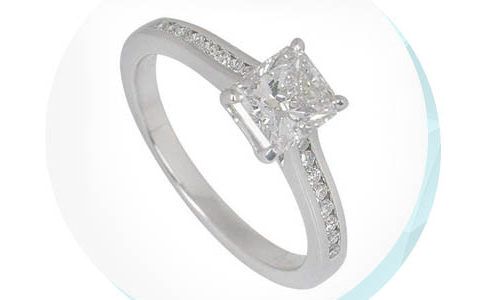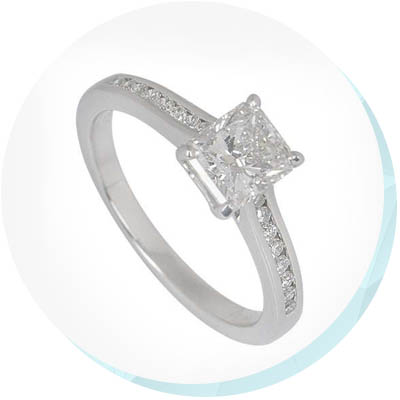INSPIRATION
The Origins of Diamonds


The Origins of Diamonds
From the bowels of the earth to the luxury jewellery in the shop window, diamonds have a long and interesting story to tell. More than simply objects of beauty, diamonds have long symbolic associations with the values of love, romance, endurance, and commitment. In their shining splendour, they are nevertheless also one of the toughest substances on Earth. In fact, the word diamond comes from the Greek “adamas”, meaning roughly “unconquerable”. In this way the diamond is perhaps the ultimate symbol of the endurance of something special or, in other words, the power of love.
The Formation of Diamonds
Diamonds are most fundamentally crystallised carbon and are the result of billions of years of intense heat and pressure applied, deep within the Earth, on that carbon. For the pressure and the heat to be enough to trigger the crystallisation process, we would have to travel 150 to 200 km, below the surface of the planet. At this depth, temperatures average 900 to 1300°C and pressures can reach 45 to 60 kilobars. For comparison, this represents a pressure 50,000 times greater than the normal atmospheric pressure at the Earth’s surface.
It is under these extreme conditions that diamonds begin to form. Molten rock, known as magma, is created within the same vicinity as the carbon that is pressurised into diamonds. This magma expands and, when this happens, is forced up towards the planet’s surface, breaking layers of rock as it goes. Importantly, this action of expanding and rising magma also brings with it the diamond-bearing rocks from either the level where the magma is formed or the path of the magma as it rises.


Magma Pipes and Gems
As this magma (or more specifically, molten kimberlite and lamproite) rises towards the surface, it moves with incredible speed and force. This causes it to take the path of least resistance, thus forming a magma “pipe” towards the surface. It is in and around these pipes that diamonds are found. And yet, only 0.5% of kimberlite pipes contain any gem-quality diamonds – that speaks to the rarity of the set of heat and pressure conditions that lead to diamonds being formed. It doesn’t happen often, even down within the extreme pressure-oven conditions of the Earth’s mantle.
It is a common misconception that diamonds form from coal. In fact, diamonds have very little to do with the common black substance which results from organic material being under pressure for a long period of time. Diamonds do not come from plant matter; in fact, the majority of the Earth’s diamonds were formed long before the appearance of the first land plants. Diamonds are something much older – and their formation much less likely.
As well as being extremely high, the pressure and temperature levels that form diamonds are also rather rare, and certainly not found all around the globe. In fact, it is a combination of conditions, thought only to occur in the mantle underneath the stable interiors of continental plates. These areas have been dubbed “diamond stability zones”. It is from here that diamonds are transported upwards by pipe-forming kimberlite magma, allowing humans to reach them (we are still impossibly far from being able to dig deep enough to reach the diamond stability zone). Furthermore, the type of eruptions that do actually transport diamond-bearing rocks to the surface are so rare that they have in fact never been observed by modern humans. Far from being akin to coal, diamonds are a result of the most extreme and rarest of geological events.
The History of Diamonds
800 BC - First Discovered & Mined in India
The history of human mining or collection of diamonds (as far as we know) dates back to the fourth century BC when they were known to have been discovered and mined in India. Yet although over 2300 years ago, this is a tiny fraction as old as the diamonds themselves, which are thought to have been formed 900 million years ago. It is not uncommon, in fact, for diamonds to be dated to billions of years ago.
Diamonds ultimately came to be traded as precious items along the famous silk road trading route, which connected China to the Near East. Diamonds were at this time recognised as being excellent materials for tools, being able in their hardness to engrave metal. However, their exceptional beauty, ability to refract light, and rarity also made sure that they were recognised as the valuables which they are known to be today. From the very beginning then, diamonds were revered as precious objects.


1866 - Diamonds Discovered in South Africa
Until the eighteenth century, India was thought to be the only place in the world where diamonds could be mined; it took the depletion of the Indian diamond mines before alternative sources were even investigated. In 1866, a 15-year-old boy called Erasmus Jacobs discovered a 21.5 carat diamond on the banks of the Orange River in South Africa. This discovery led to further prospecting and, eventually, the first large-scale diamond mining operation, known as the Kimberly mine. Many more diamonds were discovered here than had been typical in the Indian mines. As a result, the world market was flooded with new diamonds and their value decreased. It was around this time that the extremely wealthy turned to coloured stones such as rubies, sapphires, and emeralds for the use in valuable jewellery.


Engagement Ring Association
There was, however, one type of diamond jewellery that these precious stones became irrevocably associated with – the engagement ring. The association of a ring shape with engagement – or betrothal – is very ancient and is found independently in several cultures. The oldest antecedent of the western tradition of engagement rings was probably the betrothal rings worn by the Romans. Their placement on the third finger of the left hand was significant because it was believed that here was found the ‘vena amorous’, which the Romans believed ran straight to the heart.
1215 - The Engagement Period was Introduced
For engagement rings, however, there had to be engagement. It was Pope Innocent II who, in 1215, initiated the ‘waiting period’ between betrothal and marriage. Rings were created to signify commitment and it was around this time that they started to be used as a major part of the marriage ceremony as well. This era was characterised by a high degree of social stratification and thus rings would also represent social rank. It was to distinguish nobility that the first ornate or jewelled rings became common.


1477 - The First Diamond Engagement Ring
It was not, however, until 1477 that we have the first mention of a diamond engagement ring. Archduke Maximilian of Austria proposed marriage with such a ring, which would have had tremendous value, so rare were diamonds at this time. It was the diamond’s strong association with beauty, preciousness, but also hardness, commitment and strength that made it a perfect jewel for use in engagement rings.
The tradition of the diamond engagement ring has been strong ever since and diamonds were not long in becoming the standard jewel for engagements. Ever since South African diamond mining increased the global supply and made them affordable, diamonds have held on to an undisputed position as the engagement gift par excellence.

